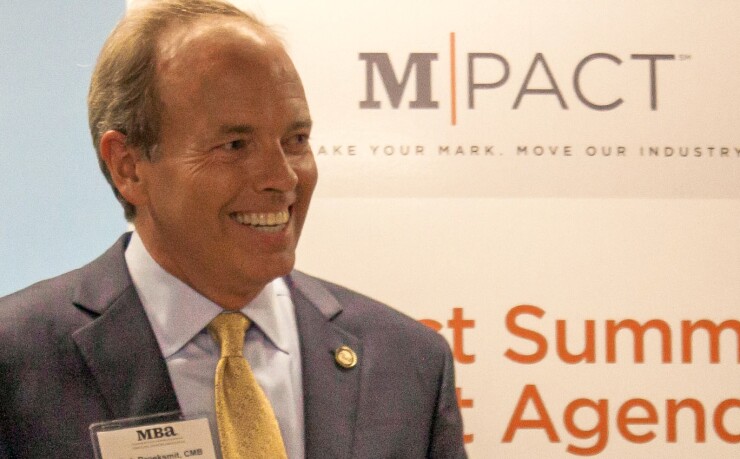The overall forbearance rate
But the broad liquidity facility that

Below is a discussion with MBA President and CEO Robert Broeksmit about the current state of liquidity needs in the mortgage banking industry, and the risks that remain for the housing-finance system. His responses are excerpted and edited for length.
Why is it so important to have a broader public liquidity facility available for servicers? I know you've noted there's been a lot done to try to assist mortgage companies, but there are still gaps. Can you talk about what those are?
A couple of points: One, while there is a Ginnie Mae liquidity facility, it only covers principal and interest, not tax and insurance escrows. On a typical Ginnie Mae loan — that is, FHA, VA or USDA — the taxes and insurance are about 30% of the total payment. So that is a pool of obligation for the servicer for which there's no Ginnie liquidity facility.
The other need would be for, of course, a liquidity facility related to advancing obligations for Fannie Mae and Freddie Mac loans with forbearance. We've had the very helpful curtailing of Fannie Mae advances at four months rather than the previous 12 months, which certainly significantly reduces the worst-case obligation for servicers. But those servicers still — depending on the composition of their portfolios — have up to four months of obligation for principal and interest as well as taxes and insurance for Fannie and Freddie. If the forbearance were to last up to 12 months under the CARES Act, the servicer would still be advancing the insurance and the taxes throughout that whole period.
The final piece is for loans in private-label securities as distinct from loans on bank balance sheets. For banks, of course, there’s no advancing; but on PLS, typically the advancing requirements are similar to the GSEs'. They can vary investor to investor, but typically, there are advancing requirements of some kind. Our forbearance study doesn’t break down the forbearance rate for private-label securities as distinct from banks, but the aggregate category we have for the two combined is higher than the overall forbearance rate, so that’s another obligation that servicers have.
Many of the large nonbank servicers have announced that they have raised additional liquidity in the private market and we expect that, with the current take-up rates, they would not need to access a facility should one be set up. So at the current levels, we're optimistic those servicers will meet their obligations for now, but we don’t know where these forbearance rates will go.
Right now, you may have a situation where — on average — the servicers are able to meet their current obligations. But you also may have certain servicers that, based on their particular portfolio mix, might not be able to. They could, for example, have a geographic concentration in areas that are particularly hard hit by the pandemic and the economic fallout, or perhaps they specialize in a certain type of first-time homebuyer that is more likely to request forbearance.
Absent a broader government liquidity facility, what other potential sources of liquidity are there?
There are private-sector sources of liquidity, as some of our members have disclosed in their earnings releases and other updates. We think there could be more private-sector lending against Ginnie Mae advances, but there are some technical issues with the way Ginnie Mae interprets its agreements with servicers that make Ginnie Mae advancing less viable as collateral for private-sector advances. So we're working with Ginnie Mae, and we proposed some language that would amend the National Housing Act that we think would make it easier for servicers to access more liquidity and private capital backed by Ginnie Mae advances. That's another source that we think could also help with taxes and insurance. If you think about it, the Ginnie market offers pretty close to risk-free lending because it’s backed by the full faith and credit of the U.S. government, but because of some technical issues with how the acknowledgement agreement is interpreted, it makes it a less viable collateral for private sector lending.
I was examining
That's right. My understanding is that that facility is within a broader facility that also finances mortgage servicing rights for some of the bigger issuers. Smaller Ginnie servicers can access the PTAP program but, again, that only covers principal and interest.
So the big picture is that there's still a need for a broader source of liquidity?
You do have states starting to slowly open back up and you have some borrowers already exiting forbearance, which are very positive signs, but you also don’t know how long the fiscal stimulus will continue and whether, when that wears off, the forbearance take-up rates will rise again. Because of all that uncertainty, we believe that if the Treasury and the Fed were to say, "We can get a liquidity facility set up expeditiously, should the need materialize," it would do a great deal to reassure the market.
I also wanted to ask about the outstanding issues related to forbearance from a lender’s perspective. It sounded like the FHFA guidance related to
That's right. We were very gratified with the announcement from [FHFA] Director [Mark] Calabria that makes it clear that, if borrowers have not missed payments while in forbearance or if they got caught up on any payments they might have missed, they are eligible for a new purchase or refinance loan without delay or penalty; and if they have gone into forbearance and missed one or more payments, they are eligible for a new loan once they have made three on-time payments under the terms of their deferral plan — which, I think, is what most people will use. That's good for access to the market by some consumers.
But the fact that Fannie and Freddie will not buy cash-out refinances in forbearance has led to lenders stopping originating those loans through some of their channels. Or they may have put significant pricing increases and/or underwriting overlays like higher down payments or credit scores on cash-out refinances. So, we are seeing the availability of those loans diminish, and we are continuing to work with FHFA to include cash-out refinances in Fannie's and Freddie's purchases of loans with forbearance.




